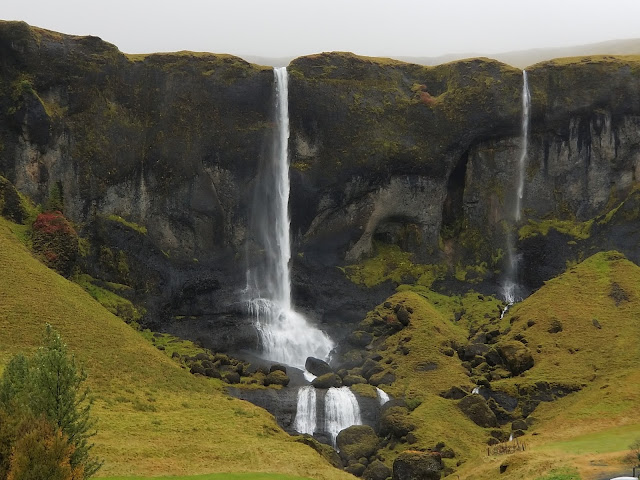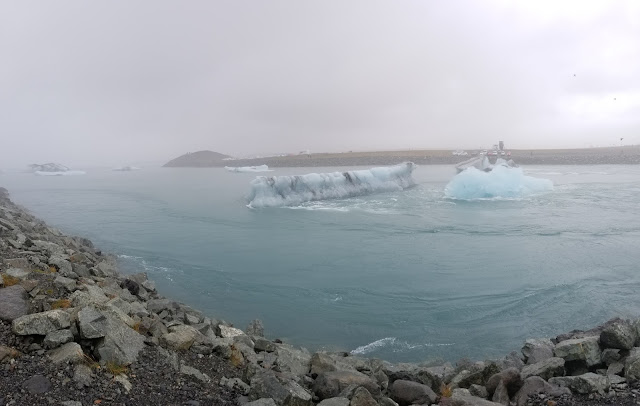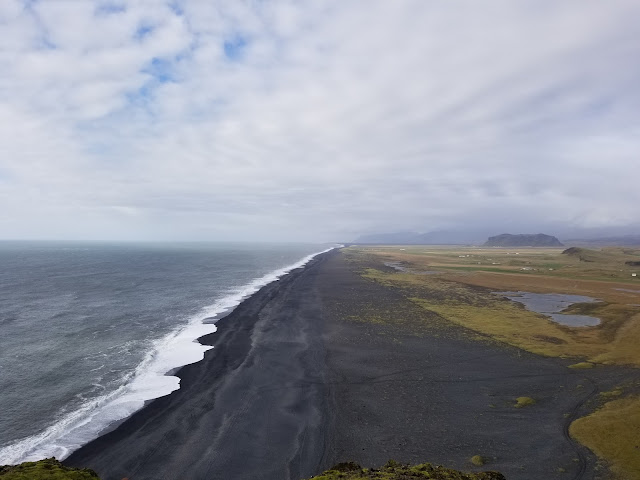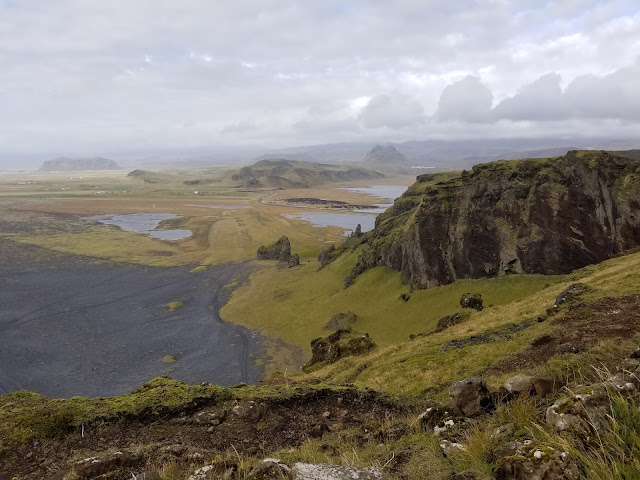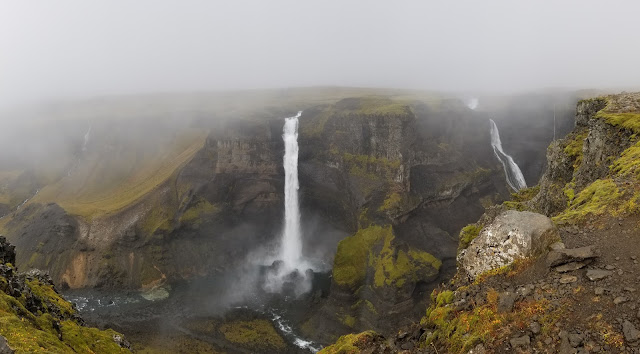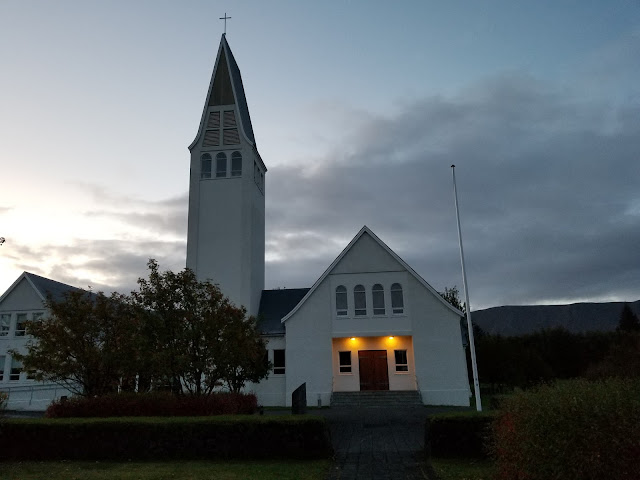Day 4: Vik to Höfn and everywhere in between
Starting with Fjaðrárgljúfur (Troll land) Try pronouncing that one
Fjaðrárgljúfur is a short canyon about 2 km long and 100 m deep but stunning all around. There are 3 viewing areas with the last being the largest and also the BEST as you can see this near waterfall and have the “iconic” shot of the canyon.
The moss covering mostly black rock was seriously cool, and some of the rock formations were unreal. There’s an arch in this picture.. can you spot it?
Looking down at the beautiful Fjaðrár river that flows through the canyon
There is no food facility but there were surprisingly decent bathrooms with flushing toilets. We suspect it is because tour buses stop here. It is is also a short dirt road to get here, but fear not. Conditions were fine so any car should be able to do it.
The iconic spot
Then we were on our way to our next spot just down the road: Kirkjugólf. Above is another moving car window photo through the rain but that waterfall was just too cool NOT to photograph!
Kirkjugólf is an 80 square meter expanse of columnar basalt stone slabs which have eroded over time. It is an easy pull out off the ring road, taking you less then 2 minutes out of your way. The parking area is well marked and then it is a quick 5 minute walk about to the stone slabs. Along the way you will pass this cool burial mound.
There basalt tiles are definitely cool and a little bit off the typical “do when in Iceland” track. Considering it is a 10-15 minute stop, it’s a pretty easy thing to squeeze in and break up your drive as you head to the glaciers.
Certainly makes for cool pictures at least
More stunning waterfalls that you will just pass on your drive… Legit took these from a moving car…. Sometimes there’s places to pull over and other times not. Driving in this country was NEVER a dull moment.
More roadside waterfalls.
Entering glacier territory. Both of the two glacial tongues belong to Vatnajökull, the largest glacier ice cap (*by volume) in all of Europe! We would be later walking on the tongue to the right, so keep on reading!
A rainbow touched down on one of the outlets as we drove by
Fall colors with the glacier shrouded in clouds
As we had a tight timeline for the day considering a tour at 4:00 PM, we headed past Skaftafell and straight on to Jökulsárlón.
A large tourism boat being dwarfed by the GIANT icebergs in the distance
As you drive NE on the ring road, there are several pullouts in between the smaller glacier lagoon known as Fjallsárlón, and the main Jökulsárlón parking area. HIGHLY recommend stopping at one of them as they are way less crowded and you can still get amazing shots of the glaciers from these beaches.
Then continue on toward Jökulsárlón. There are parking areas on either side of the bridge from which to watch the REALLY GIANT icebergs be pushed out of the bay and into the sea.
When we got to Jökulsárlón, the lake was VERY misty making the icebergs seem to just appear out of the clouds. It was VERY surreal, and maybe the coolest thing I laid eyes on in all of Iceland. We were finally understanding what the “big deal” was about these glacier lakes.
Tiny boat. BIG Icebergs
Unedited, UNREAL landscape
Jökulsárlón developed as a lake as the Breiðamerkurjökull glacier receeded from the Atlantic Ocean. It was first created post the Little Ice Age (1600-1900), when the temperatures rose and the Breiðamerkurjökull glacier tongue rapidly retreated, continually creating icebergs of varying size, thus creating a lagoon in its wake around 1934.
The size of the lake has increased 4X since the 1970s and is now the DEEPEST lake in all of Iceland with it’s deepest points reaching a depth of 248 m (814 ft) deep.
On a clear day, you can see the Vatnajökull Ice cap in all it’s glory, as well as a potential to see seals swimming or actually lounging on some of the icebergs. Of all the potential reasons to go back to Iceland, that is probably the biggest draw. I don’t regret seeing these incredible icebergs shrouded in in mist, but what I wouldn’t give to also see them on clear sunny day!
There are many walking paths along the lake. If you have time, you can walk along where all of the parking areas are. We probably passed a few before we ran short on time and had to move on.
A cool boulder along the walking path with icebergs in the background
Last iceberg from Jökulsárlón
Just on the North side of the scary 1 way bridge at Jökulsárlón, there is a parking area on the right. If you park there, you can walk out to what is called Diamond Beach and another DO NOT MISS spot.
Pieces that break off the icebergs from Jökulsárlón as they float out to sea get pushed back by the waves and end up on a volcanic black beach so they really sparkle in contrast.
There is a range from opaque white to crystalline blue and from small fragments to giant thrones! Unfortunately it started really coming down on us just as we got here so it was hard to keep our lens dry and even harder to really want to stay and enjoy. We walked around for a bit and once we were thoroughly soaked, we headed back to the car.
Next stop as we head back to Skaftafell: Fjallsárlón. In other words, the OTHER iceberg lagoon. This one is just south of Jökulsárlón and a bit smaller of a lagoon. So the question is… which one do you visit?
And the answer is definitely BOTH! While there were less icebergs in Fjallsárlón, the cool part about this lagoon is being able to SEE the Vatnajökull glacier tongue where the icebergs break off from making the overall backdrop of this lagoon a bit more stunning.
It is definitely a quicker stop, but definitely worth doing. There’s also a small bistro here that you can grab a quick coffee or snack to warm up before heading on to your next destination. In our case, we were headed BACK to Vatnajökull national park.
Candid “hipster” photo with the Vatnajökull National Park sign (we seriously didn’t pose like this!)
Some may be confused when they here all these national park terms thrown around like “Skaftafell” and “Jökulsárgljúfur” so to clear it up…. both of these national parks are part of Vatnajökull with Skaftafell being the more Southern region.
Vatnajökull National Park was established on 7 June 2008. When established, the park covered an area of 12,000 km2, but with recent additions of Lakagígar, Langisjór, Krepputunga and Jökulsárlón it now covers 14,141 km2 or approximately 14% of Iceland, making it Europe’s second largest national park in terms of area after Yugyd Va in Russia.
As far as our research goes, the 2 most popular things to do in the “Skaftefell” region are glacier walk tours, and Svartifoss. Our tour wasn’t until 4 PM and we got to the park approximately 2:30 PM. Plenty of time.
The hike to Svartifoss is a climb, but relatively short and beautiful! Most of the review on tripadvisor were saying you need 2 hours as the hike is quite steep… but we really only had an hour before we needed to show up for our tour and get fitted for crampons and so on. So we hauled ourselves up the path as fast as we could knowing we had really less than an hour once we were on the trail.
Trail deets:
Length: 3.4 km RT
Parking: There is a large but free parking area at the visitor center with free toilets
Begins at the Visitor center parking lot. You will head South through a lovely campground and follow a very well marked trail as it will take you up the hill. On the way there are 1 or 2 smaller falls and a larger one called Hundafoss that are beautiful stops to take a break (if you have time) and catch your breath.
Time: It took us just about 20 minutes to get to the first overlook but we didn’t stop at all on the way up
Admiring the fall colors and amazing waterfall while catching my breath at the top
Looking out toward the sea and black sands of the coast from the top of the hill. Loved all the Fall colors on this hike!
From the top of the hill, there is a nice path down to a beautiful bridge and then another path to a viewing platform closer to the falls. I read that some would hike right up to the base but the foot path was blocked off so they definitely do not want you going closer. No matter because this was the view I came for. I just LOVE Basalt columns and the rainbow on the right made an awesome addition to photos.
We took a little bit more time hiking down to appreciate the views of Hundafoss
Fall colors around the beautiful Hundafoss
So I have since learned there is a SHORTER and somewhat easier option for this hike where you can drive to a higher elevation and park closer. Here are the details for that:
Continue driving on the park road west past the Visitor Center. The road narrows into an almost single-lane road and climbs steeply up until reaching a small car park. From here the trail is easy to follow and will take you out on the other side of the waterfall from where the longer trail takes you. (meaning you will have different far away views and will NOT see Hundafoss) The beginning is easy but at the end to get closer there are many steps. Steps are large and well maintain but there are no rails so use caution.
Distance for this route is only 1.5 km RT.
A map showing the small road that continues past the visitor center and up some short switchbacks.
The waterfall was great and we were feeling even better about the sunny weather we were experiencing so far in Vatnajökull national park. We made it down just in time to get fitted for our boots and crampons, refill our waterbottles, grab as snack, bundle up with more layers, and board the bus.
Our guide shows us a deep crevasse and a line in the ice where very dense ice meets less dense ice
We booked a tour with Extreme Iceland for their competitive pricing, all around good reviews, and one of the longest times on the ice for a shorter tour. The bus ride over was a quick ride and then they split our large group into 3 with less around 10 people per guide. We walked through some pretty colorful rock (red and black) before finally reaching the ice and donning our crampons. Overall the tour length was solid, but moving pace fairly slow. Of course this glacier is IMMENSE and the further along you go, the more danger and crevasses there are but it would have been nice to go a bit further out. Overall however the views can’t be beat and I would highly recommending taking a tour out onto one of these incredible glaciers. To see the tour we used click here: Extreme Iceland
Selfie as we start out on the dirty ice of the end of the glacier. While the ice cap that connects all of these glaciers is Vatnajökull (the largest ice cap in Europe) most of the tongues have different names. The one we toured on was called: Svinafellsjokull
Looking at the very cool mix of glacier ice and Volcanic rock from where the glacier tongue is currently retreating.
Once we had our crampons we headed out over deeper ice sticking close to our guide to avoid any of the crevasses. We would occassionally stop for photo ops, information, or to keep the group together. One of the stops gave us a cool look at the people learning to ice climb
The Svinafellsjokull glacier outlet with the incredible Vatnajökull ice cap in the background
Fun fact: The Icelandic word jökull means glacier and Vatnajökull National Park happens to contain the largest glacier in the world outside the Arctics.
Fun fact: The Icelandic word jökull means glacier and Vatnajökull National Park happens to contain the largest glacier in the world outside the Arctics.
Group photo
While I have previously seen and walked on glacier before (thanks Canada!) there is something truly special about these glaciers in Vatnajökull. The Volcanic black sand and rock that gets trapped in the ice as the glacier flows, creates an incredible landscape of contrast between blue, white, and black.
Several films and shows have been filmed on this glacier including the most recognizable (to me at least) Interstellar and Game of Thrones.
A closer up view of the ice cap! Amazing!
Our tour concluded right around 7:00 and not only were we starving but we faced about a 2 hour drive to our lodging (and really the next town) to grab some grub. We hopped in the car and drove straight to our apartment for the night to check in (before it got to late) Luckily we did to since the restaurant we had our eyes on closed at 9 (right when we got to town) so our host recommended another great affordable option that was open until 10.
Introducing the Lobster pizza. Hofn is actually famous for their lobster (which is normally very expensive like everything in Iceland) so I was thrilled to not only find it available for under $25 but in pizza form! Braden also ordered a burger at Z bistro which was amazing and delicious for right around $20. The apartment/ guesthouse we stayed the night in was just outside of the town attached to the host’s home. It was very clean and nice and had another excellent kitchen, teas, and coffee! I would definitely recommend it as well, especially if you have 4 people to split the cost among. Click here to check out Sefdalur Studio Apartment.
Total drive time day 4: Roughly 400 km and 5 hours
Day 4 Costs:
Rental Car breakdown for 2 people per day cost: $66
Total gas breakdown for 2 people/ day: $18
Sefdalur guesthouse for 4 people: $325, so $162.50 for Braden and I
Coffee at Glacier lagoon: $4
Glacier hikes $94.85 pp
Dinner at Z bistro $45
Day 4 Total: $485







